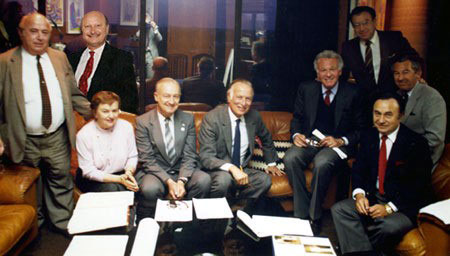History of the Holocaust Memorial
AN IDEA
In 1984, a small group of Holocaust survivors joined together to develop a permanent memorial in Miami to the six million Jews who perished at the hands of the Nazis. A year later, the Holocaust Memorial Committee was formally established as a private non-profit organization.
The committee decided that Miami Beach was the perfect location for such a memorial, as South Florida has one of the highest populations of Holocaust survivors in the United States, with many of them residing within the city limits.

“There are 20-25,000 survivors in this region,” the late Abe Resnick, one of the founding committee members and a Miami Beach City Commissioner, told The Miami Herald in 1985. “We felt this is the right place to put up a monument to represent all of Florida.”
VOICES AGAINST THE MEMORIAL
As preparations were being made to build the Memorial, there were those who objected to its erection. Several disapproved, arguing that Miami Beach was a place for “sun and fun” and the Memorial would be too somber for the vacation destination.
“Gloom is doom! Don’t turn one of this city’s few bright spots into a cemetery,” said Miami Beach Garden Club member Florence Shubim. In the mid-80s, the Garden Club had plans to expand their center adjacent to where the Memorial stands, which were quashed by the Memorial’s proposed footprint.
Others said the Memorial’s presence on city-owned land violated the separation of Church and State, arguing it was a religious monument. While the Memorial is in memory of the six million Jews who died during the Holocaust, it is a patently historical monument and any religious symbols were removed.
A PLEA TO THE CITY
On November 27, 1984, approximately 500 people packed a meeting of the Miami Beach Planning Board. Dozens of Holocaust survivors from across South Florida were bused in for the meeting, many making emotional pleas to the Board and hoping to sway votes.
“I lost five sisters and five brothers,” 79-year-old Clara Linder said in Yiddish through a translator, The Miami Herald reported. “They were all killed.”
Machela Oksenhenbler, 80, pulled up her sleeve to show a grainy tattoo on her forearm bearing the numbers 54092, put there by the Nazis.
The Planning Board unanimously approved the Memorial; eight days later, the City Commission also approved plans for the Memorial.
A BASHERT LOCATION
The proposed location spanned several city blocks with a physical address of 1933-1945 Meridian Avenue, street numbers that exactly match the years of the Nazi regime and its war against the Jews. The coincidence led many to believe the location of the Memorial was bashert (fate), and also helped convince several city legislators that the Memorial belonged in that specific spot.
DESIGNING THE MEMORIAL
The Holocaust Memorial Committee then turned to architect Kenneth Treister with the immense challenge of conveying the unimaginable and remembering the unthinkable: designing the Memorial.
Click here to read about Treister's creative journey, in his own words
“Imagine you’re in a concentration camp in Poland surrounded by the Nazis, no communication with the outside world and you’re suffering and you’re a martyr, you’re giving up your life,” Treister said, discussing how he thought about memorializing the Holocaust vicitims. “Each one probably died thinking that no one would ever care, no one would ever know, no one would ever remember.”
>Photo Gallery: Construction of the Memorial
>Video: Creating the Holocaust Memorial Miami Beach
Treister’s initial sketches showed an outstretched arm, reaching for the skies as hundreds of small human figures cling to it and to each other. Other early drawings show emaciated people reaching out for help, a naked woman holding onto her baby and a small child, huddled and crying under a blanket.
Critics of Treister’s design said the Memorial’s focal point, the more than four-story-high outstretched arm, tattooed with a number from Auschwitz was “grotesque,” and a “brutal intrusion on the cityscape.” Holocaust survivors and committee members said that was the point.
“To one who would say it is not acceptable, not tasteful, not expressive, I would ask, what would he find acceptable? Would he find it acceptable for me to stand on a street corner and weep?” founding committee member and Holocaust survivor David Schaecter told The Miami Herald in an April 1987 article.
Triester’s design was eventually approved and he set off to have the bronze sculpture cast in Mexico City foundry Fundiciòn Artística between 1987 and 1989. Giant blocks of pink-hued Jerusalem stone were brought in from Israel and set as the Memorial’s foundation and watched diligently by the late Resnick, who, his family said, would guard the Memorial overnight, afraid thieves would steal the pricey materials not yet secured to the ground.
A DREAM IS DEDICATED
The Memorial took more than four years to build, and on Sunday, February 4, 1990, a dedication ceremony was held with Elie Wiesel, Nobel Laureate as guest speaker.
“One day, a man or a woman will enter this sanctuary of remembrance and wonder: Was it all true? Were the killers really that cruel? And the victims that helpless? That lonely? That abandoned?” Weisel said.
“Will this museum, or any other, bigger or smaller, make a difference? I hope that visitors will bring their children. I hope they will look at the pictures. Pictures: Old emaciated grandparents lying in the street. Naked mothers shielding their children. A group of SS men enjoying themselves while tormenting an old man, who looks like my grandfather, and everyone else’s.
“Look at his face. Look at all the faces. Look and you will realize that there existed a suffering that transcended suffering. Woe unto us, for the tragedy which this museum is trying to integrate is beyond words, and beyond imagination, but not beyond memory. And only those who were there know, will know, what it meant being there.”









 Holocaust Memorial Miami Beach, a Committee of the Greater Miami Jewish Federation
Holocaust Memorial Miami Beach, a Committee of the Greater Miami Jewish Federation